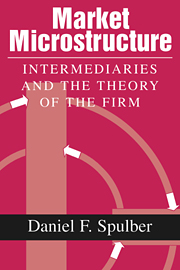Book contents
- Frontmatter
- Contents
- Preface and acknowledgments
- Introduction
- Part I Market microstructure and the intermediation theory of the firm
- Part II Competition and market equilibrium
- Part III Intermediation versus decentralized trade
- 5 Matching and intermediation by firms
- 6 Search and intermediation by firms
- Part IV Intermediation under asymmetric information
- Part V Intermediation and transaction-cost theory
- Part VI Intermediation and agency theory
- Conclusion
- References
- Index
5 - Matching and intermediation by firms
Published online by Cambridge University Press: 18 December 2009
- Frontmatter
- Contents
- Preface and acknowledgments
- Introduction
- Part I Market microstructure and the intermediation theory of the firm
- Part II Competition and market equilibrium
- Part III Intermediation versus decentralized trade
- 5 Matching and intermediation by firms
- 6 Search and intermediation by firms
- Part IV Intermediation under asymmetric information
- Part V Intermediation and transaction-cost theory
- Part VI Intermediation and agency theory
- Conclusion
- References
- Index
Summary
Intermediaries compete with direct exchange to attract buyers and sellers. Consumers and suppliers choose between seeking each other out and bargaining over the terms of trade and exchange with the intermediary. Because consumers and suppliers must incur costs of search and bargaining under decentralized trade, intermediaries will be economically viable if they can carry out transactions at a lower cost. By demonstrating that intermediaries are profitable in equilibrium, the models examined in this chapter help to explain the role of firms as intermediaries. Firms will form in a pure-exchange economy if they are viable in competition with direct exchange.
Models of matching and bargaining present a picture of markets as decentralized mechanisms with pairwise meetings of agents. Rubinstein and Wolinsky (1985, p. 1133) observe that such models contribute to “an understanding of the micro-mechanisms of price formation and their role in shaping market outcomes.” In contrast, intermediated markets are more centralized because the intermediary deals with multiple buyers and sellers. Price-setting intermediaries provide an explicit mechanism of price adjustment that differs from pairwise bargaining.
The intermediation models presented in Chapters 2 through 4 examined monopoly pricing, Bertrand–Nash competition between intermediaries and monopolistic competition in a general-equilibrium setting. These models emphasized price setting and market clearing by firms without explicitly allowing for direct exchange. This chapter presents several models with searching or matching costs in which intermediaries increase the likelihood of trade or improve the terms of trade relative to direct exchange.
- Type
- Chapter
- Information
- Market MicrostructureIntermediaries and the Theory of the Firm, pp. 117 - 139Publisher: Cambridge University PressPrint publication year: 1999



